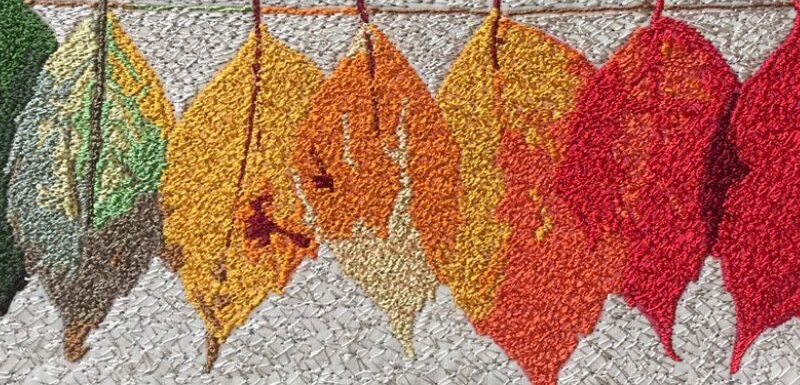If you want to enjoy a trouble-free experience when thread sketching or thread painting, knowing how to prepare your fabric for thread sketching is vital. We all begin a new project with high hopes that it will be our next masterpiece.
But things don’t always go according to plan!
This article guides you through some fundamental information and tips to help you avoid any issues with puckering or pull-up spoiling your day.
- Tension, Warp and Weft
- Thread sketching challenges the grain
- Choosing the best fabric for thread painting
- How to prepare your fabric for thread painting: What goes underneath?
- The case of the puckered feather
- Choosing a stabiliser: It's what's underneath that matters
- The four basic types of stabiliser
- Best stabilisers for thread painting
- Get the Complete Guide to Stabilising
- Related posts
Affiliate Disclosure: Some of the links on this site are affiliate links. This means I may receive a small commission (at no further expense to you) if you click through and make a purchase. ThreadSketchingInAction.com is a participant in the Amazon Services LLC Associates Program, an affiliate advertising program designed to provide a means for sites to earn commission fees by advertising and linking to Amazon.com.
Tension, Warp and Weft
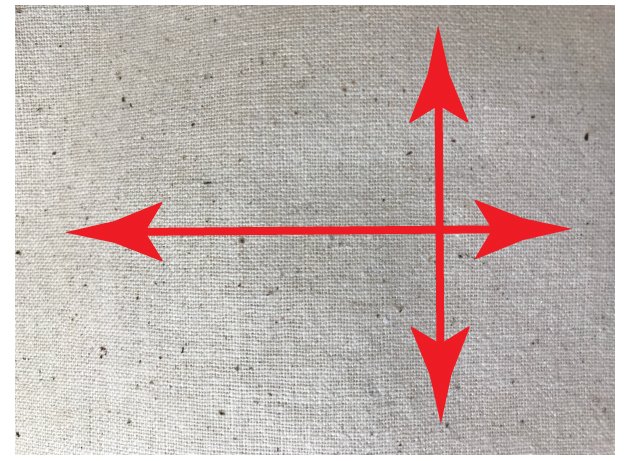
The simple act of stitching on fabric creates tension because we are working on woven fabric, with threads running at right angles to each other. Woven fabric is made up of warp and weft threads, which are referred to as the grain of the fabric.
The straight grain runs the length of the fabric, while the cross grain runs from selvedge to selvedge.
A third type of grain is the bias grain which is diagonal to the warp and weft. Any woven fabric cut “on the bias” will tend to stretch very easily, making it ideal if you need to manoevre the fabric around a curve.
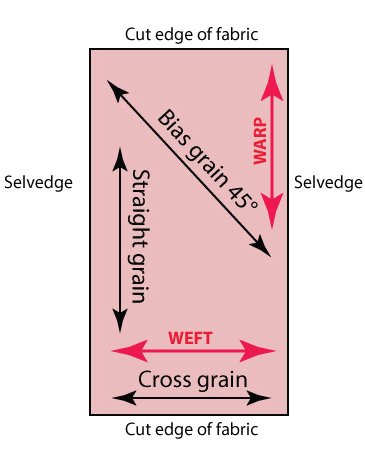
Thread sketching challenges the grain
When we start thread sketching or thread painting, the often diagonal or random direction of the stitching challenges the orderly nature of the warp and weft threads.
So what effect does this have on the underlying woven fabric?
Unfortunately, unless the fabric has a very firm weave, or has been adequately stabilised, the warp and weft threads are likely to pull out of alignment.
This has the effect of distorting the fabric, completely altering its orderly shape.
High thread count fabric
It’s possible to minimise any distortion of the weave when you stitch by selecting high thread count fabric for your design.
‘High thread count’ refers to the density of the warp and weft threads per square inch of fabric. Most people have encountered the term ‘thread count’ when purchasing bed sheets and other fine linen.
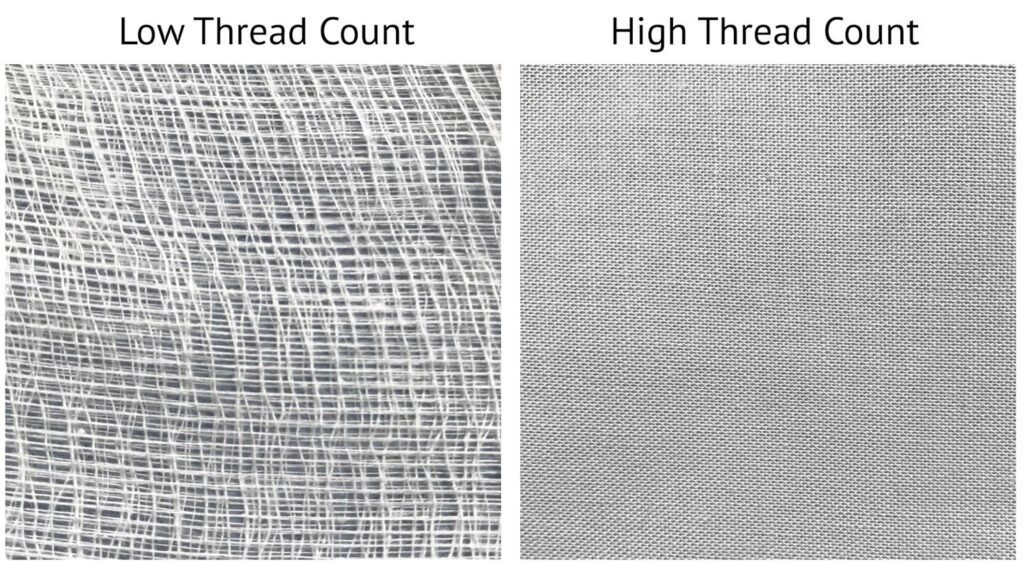
High thread count is generally considered higher quality than low thread count.
Why?
Weaving more threads together in a small area understandably requires using finer gauge thread, and more strands. This leads to the creation of a softer, more luxurious fabric. These finer threads can be woven closer together — so there will be more threads per square inch — creating a firm and smooth fabric surface.
While we don’t necessarily need ‘luxurious’ fabric for thread painting, choosing high thread count fabric offers more stability when you begin stitching over the top.
This is especially the case when employing the random stitch directions that thread painting often entails.
Take a fabric like gauze, for example (see picture above left) — the sort used for hospital dressings and bandages. Its loose, open, and light structure means it’s easily pulled in any direction, with a weave that is easily distorted.
Of course, the loose weave is ideal for binding someone’s elbow, but can you imagine trying to thread paint on it?
Would stabilising the gauze help?
What if you stabilised the gauze, I hear you ask?
Of course, stabilising would help, providing you chose a very firm stabiliser. But then you’d lose the effect of the distorted gauze, potentially rendering null any unusual effect you were trying to achieve.
What about using an embroidery hoop?
Even working on the gauze in a hoop would be challenging. The very nature of gauze, with its loose weave, makes it difficult to stabilise when stretched across a hoop.
Choosing the best fabric for thread painting
Of course, most people do not want to work with gauze, so what is the best fabric for thread painting, both in thread count and quality?
Recommended fabric for thread sketching and thread painting:
- Good quality 100% cotton quilting fabric, e.g. Kona solids
- High quality PFD (Prepared for Dyeing) fabric (100% cotton), e.g. Kona Cotton PFD Bleach White
- Batik fabric, which usually has a high thread count, e.g. Soimoi Batik Fabric
If you’re constrained by budget (which many of us are!), be wary of the temptations of inexpensive quilting fabric. In my experience, it’s simply not worth the ensuing disappointment.
It’s much better to buy a smaller quantity of good quality fabric and use it with care.
How to prepare your fabric for thread painting: What goes underneath?
Thread painting requires a thorough approach to stabilising before you begin stitching.
And the nature of what you’re making (i.e. the density of your planned thread sketching or thread painting) is what determines which stabiliser you choose.
If you intend stitching very heavily, then always err on the side of using a very firm or heavy stabiliser.
There are many brands available — be aware that brand names often differ around the world, even when the product is the same.
Stabiliser brands include (but are not limited to):
- Pellon
- Buckram (by Pellon and other brands)
- Sulky
- Legacy
- TearEasy
- Clover
- Floriani
- Gütermann
- New Brothread
Using a hoop, as well as stabiliser, allows you to use medium-weight stabiliser if it’s better suited to your project. And a hoop plus medium-weight tear-away stabiliser is a good option when you want to remove some of the stabiliser after stitching.
For most other heavily stitched thread paintings, I always recommend using a very firm stabiliser.
There will always be times when, however thoroughly you plan your stabilising, puckering and pull-up may occur. Nevertheless, this issue can be overcome with practice and experience.
The case of the puckered feather
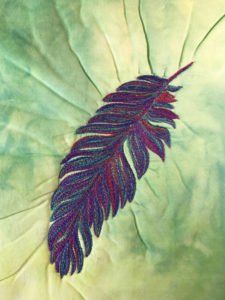
When preparing this article, I decided that I needed an example of ‘extreme’ puckering. This feather was the result.
It’s worked on a standard quilt sandwich (i.e. cotton backing, low-loft batting, and cotton top). I hate to admit this — please don’t hate me — but I actually found it difficult to get this thread painting to pucker, even though the base contained no stabiliser at all!
Why did I make this sample?
Although I found causing deliberate puckering difficult this time, this hasn’t always been the case. I do understand the frustration of puckering and pull-up.
However, many years of practice and experience have taught me how to overcome the problem. Achieving a great result does become easier — with practice.
Choosing a stabiliser: It’s what’s underneath that matters
Choosing the perfect stabiliser requires considering various aspects of what you’re planning to make. Experimentation, exploration, and practice ultimately lead to you developing the ability to make excellent choices.
Learn what works for you and what doesn’t. We’re all different and no two people will ever do things the same way.
The four basic types of stabiliser
Amongst the myriad choices, there are just four basic types of stabiliser:
- Tear-away and cut-away
- Water-soluble and wash-away
- Heat-away and melt-away
- Leave-in place
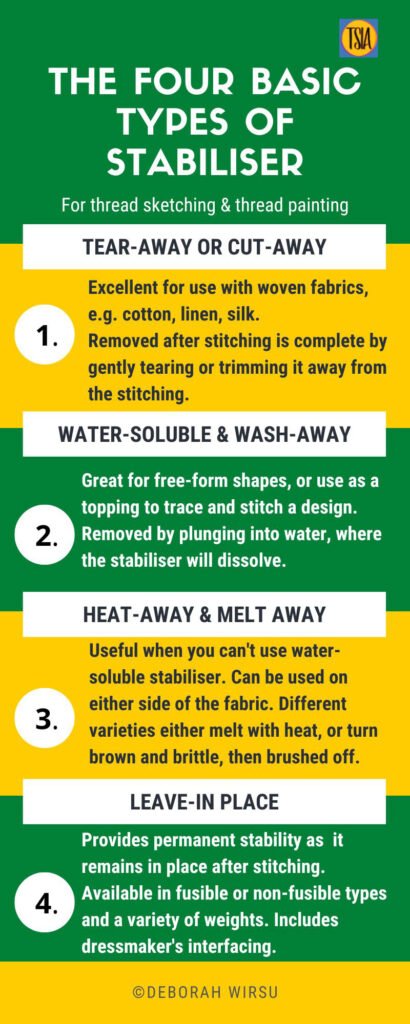
Best stabilisers for thread painting
It’s beyond the remit of this article to cover every type of project and stabiliser choice, so I’m going to focus on thread painting.
Thread painting often involves heavily stitching on your fabric, so to prevent puckering and pull-up, I recommend choosing a medium weight (minimum) to very firm (recommended) stabiliser.
Pellon (and their associated brand names) manufacture a range of excellent stabilisers, including:
Pellon Stabilizer Heavy weight.
This non-woven stabiliser is is constructed of 100% polyester and was created for sewing into heavy weight fabric.
It makes a perfect base for heavily thread painted pictures and wall hangings.
For added stability, fuse the Pellon to your fabric using Bondaweb Vliesofix or MistyFuse.
Pellon 376 Fusible Buckram Stabilizer
This stabilizer is a woven, iron-on fabric backing that adds strength and body.
It’s great for stabilising thread paintings, along with its more common craft uses, such as shaping hats, handbags, or belts.
Brothread Tear Away Machine Embroidery Stabilizer – Medium Weight
This medium weight stabiliser has proved to be fabulous for stabilising thread sketching and thread painting projects.
It is manufactured from machine washable polyester, and, being a tear-away stabiliser, is suited to a variety of different projects.
Get the Complete Guide to Stabilising
If puckering or pull-up are spoiling your day, rest assured that you are not alone.
But there are solutions — the problems can be resolved by understanding everything that goes into choosing the most appropriate stabiliser for your project.
My book, The Complete Guide to Stabilising: Your essential guide to stabilising fabric for thread sketching, thread painting, and free machine embroidery, outlines everything you need to know, in simple terms.
Fully updated and revised 2nd Edition available now.
